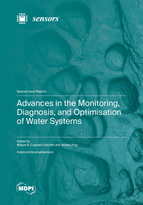Advances in the Monitoring, Diagnosis, and Optimisation of Water Systems
A special issue of Sensors (ISSN 1424-8220). This special issue belongs to the section "Remote Sensors".
Deadline for manuscript submissions: closed (10 May 2022) | Viewed by 36097
Special Issue Editors
Interests: fault diagnosis; system identification; intelligent decision support systems; process control; sensor placement; sensor data validation and reconstruction; system optimisation; data science; water systems; active noise control
Interests: planning and control of autonomous systems; supervision and advanced control of processes and systems; control of large scale systems
Special Issues, Collections and Topics in MDPI journals
Special Issue Information
Dear Colleagues,
In the context of global climate change, with the increasing frequency and severity of extreme events—such as draughts and floods—which will likely provide growing uncertainty to water demand and jeopardise its availability, utilities in charge of the management of water systems face new operational challenges because of increasing resource scarcity, intensive energy requirements, growing populations—especially in urban areas—costly and ageing infrastructure, increasingly stringent regulations and rising attention towards the environmental impact of water use. The shift from a linear to a circular economy and the need for a transition to a low-carbon production system represents an opportunity to address these emerging challenges related to water, energy, and the inefficient use of resources. In this context, the increasing number of advanced installed sensors—and the corresponding increases in available data—allow for the implementation of so-called Industry 4.0 techniques, which are strongly focused on interconnectivity, automation, artificial intelligence and real-time data acquisition, and will facilitate the development of intelligent tools in order to tackle such challenges. These challenges impel network managers to improve the methods and techniques they use for the monitoring, diagnosis, prognosis, supervision, and optimisation of the performance of water-related systems, in order to catch up with the current sustainability agenda.
Guest Editors are seeking papers that present novel approaches for the monitoring, diagnosis, prognosis, supervision and optimisation of water systems based on state-of-the-art advanced technologies in different disciplines, for example, control, automation, computer science and telecommunications in the context of high system efficiency improvements in terms of water management, energy consumption, water loss, and water quality. Papers presenting methods applied to real pilots are highly encouraged in order to show real-life impacts, whilst narrowing the gap between theory and practice as regards transitioning to a circular economy framework.
Prof. Dr. Vicenç Puig
Dr. Miquel À. Cugueró-Escofet
Guest Editors
Manuscript Submission Information
Manuscripts should be submitted online at www.mdpi.com by registering and logging in to this website. Once you are registered, click here to go to the submission form. Manuscripts can be submitted until the deadline. All submissions that pass pre-check are peer-reviewed. Accepted papers will be published continuously in the journal (as soon as accepted) and will be listed together on the special issue website. Research articles, review articles as well as short communications are invited. For planned papers, a title and short abstract (about 100 words) can be sent to the Editorial Office for announcement on this website.
Submitted manuscripts should not have been published previously, nor be under consideration for publication elsewhere (except conference proceedings papers). All manuscripts are thoroughly refereed through a single-blind peer-review process. A guide for authors and other relevant information for submission of manuscripts is available on the Instructions for Authors page. Sensors is an international peer-reviewed open access semimonthly journal published by MDPI.
Please visit the Instructions for Authors page before submitting a manuscript. The Article Processing Charge (APC) for publication in this open access journal is 2600 CHF (Swiss Francs). Submitted papers should be well formatted and use good English. Authors may use MDPI's English editing service prior to publication or during author revisions.
Keywords
- diagnosis
- real-time monitoring
- sensor data validation and reconstruction
- prognosis
- optimisation
- intelligent decision support systems
- data imputation
- artificial intelligence
- water systems








